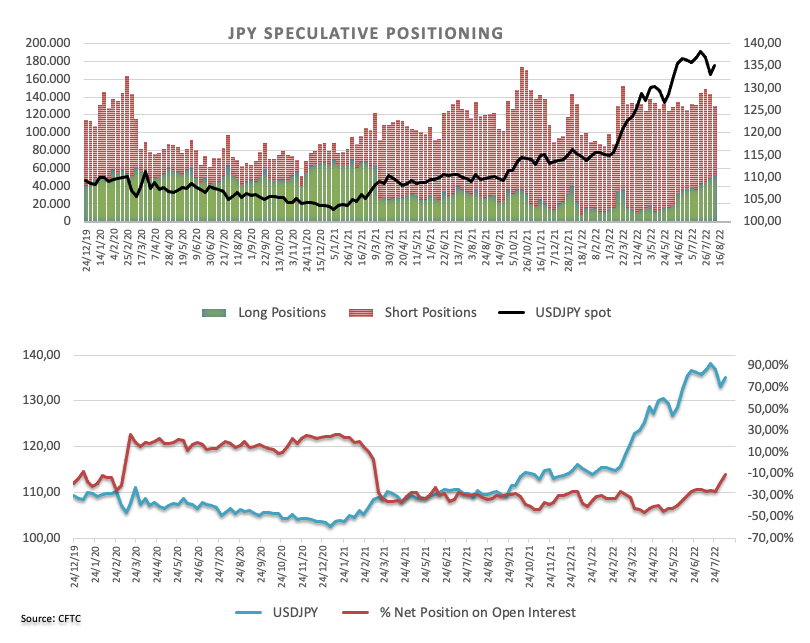These are the highlights of the CFTC Positioning Report for the week ended on August 9th:
- Speculators reduced further their negative exposure to the safe haven yen and trimmed their net shorts to levels last seen back in early February 2020. The resurgence of the risk aversion during the Pelosi’s visit to Taiwan seems to have reignited the sentiment towards the Japanese currency. However, the stellar print from July’s US NFP lifted US yields and pushed USD/JPY back to the area north of 135.00, where it met some tough resistance.
- Still in the safe haven realm, net shorts in the Swiss franc fell to 4-week lows amidst a multi-session consolidative mood in USD/CHF.
- Net shorts in the euro shrank to 4-week lows in a week dominated by the resurgence of the risk-on mood despite solid results from US fundamentals, while the impact of the Pelosi’s trip to Taiwan started to fade away. Against that, EUR/USD kept the range around the 1.0200 neighbourhood, always amidst the broader side-lined theme between 1.0100 and 1.0300.
- The speculative community scaled back their net shorts in the British pound to 5-month lows against the backdrop of the sustained improvement in the appetite for the risk complex and in spite of the “dovish hike” by the BoE at its event on August 4. That said, GBP/USD initially prints new monthly lows near 1.2000 just to regain some traction soon afterwards.
- The bearish mood remained unchanged around the Aussie dollar, as net shorts climbed to levels last seen in early March in response to the pick-up in US-China effervescence and despite the RBA hiked the OCR by 50 bps on August 2. AUD/USD attempted some consolidation which it will eventually break on the back of the better tone in the risk-associated universe.
- In the commodities’ space, net longs in the WTI dropped to levels last seen in late February 2016, as recession chatter and renewed US-Iran talks around the nuclear deal weighed on prospects for the demand of crude oil. The barrel of the WTI extended the downtrend and revisited prices seen before the Russian invasion of Ukraine. Net longs in Gold rose to 5-week highs amidst short covering, which was in turn propped up by the US economy entering a technical recession and declining US yields.
Information on these pages contains forward-looking statements that involve risks and uncertainties. Markets and instruments profiled on this page are for informational purposes only and should not in any way come across as a recommendation to buy or sell in these assets. You should do your own thorough research before making any investment decisions. FXStreet does not in any way guarantee that this information is free from mistakes, errors, or material misstatements. It also does not guarantee that this information is of a timely nature. Investing in Open Markets involves a great deal of risk, including the loss of all or a portion of your investment, as well as emotional distress. All risks, losses and costs associated with investing, including total loss of principal, are your responsibility. The views and opinions expressed in this article are those of the authors and do not necessarily reflect the official policy or position of FXStreet nor its advertisers. The author will not be held responsible for information that is found at the end of links posted on this page.
If not otherwise explicitly mentioned in the body of the article, at the time of writing, the author has no position in any stock mentioned in this article and no business relationship with any company mentioned. The author has not received compensation for writing this article, other than from FXStreet.
FXStreet and the author do not provide personalized recommendations. The author makes no representations as to the accuracy, completeness, or suitability of this information. FXStreet and the author will not be liable for any errors, omissions or any losses, injuries or damages arising from this information and its display or use. Errors and omissions excepted.
The author and FXStreet are not registered investment advisors and nothing in this article is intended to be investment advice.
Recommended Content
Editors’ Picks
AUD/USD holds hot Australian CPI-led gains above 0.6500

AUD/USD consolidates hot Australian CPI data-led strong gains above 0.6500 in early Europe on Wednesday. The Australian CPI rose 1% in QoQ in Q1 against the 0.8% forecast, providing extra legs to the Australian Dollar upside.
USD/JPY sticks to 34-year high near 154.90 as intervention risks loom

USD/JPY is sitting at a multi-decade high of 154.88 reached on Tuesday. Traders refrain from placing fresh bets on the pair as Japan's FX intervention risks loom. Broad US Dollar weakness also caps the upside in the major. US Durable Goods data are next on tap.
Gold price struggles to lure buyers amid positive risk tone, reduced Fed rate cut bets

Gold price lacks follow-through buying and is influenced by a combination of diverging forces. Easing geopolitical tensions continue to undermine demand for the safe-haven precious metal. Tuesday’s dismal US PMIs weigh on the USD and lend support ahead of the key US macro data.
Crypto community reacts as BRICS considers launching stablecoin for international trade settlement

BRICS is intensifying efforts to reduce its reliance on the US dollar after plans for its stablecoin effort surfaced online on Tuesday. Most people expect the stablecoin to be backed by gold, considering BRICS nations have been accumulating large holdings of the commodity.
US versus the Eurozone: Inflation divergence causes monetary desynchronization

Historically there is a very close correlation between changes in US Treasury yields and German Bund yields. This is relevant at the current juncture, considering that the recent hawkish twist in the tone of the Fed might continue to push US long-term interest rates higher and put upward pressure on bond yields in the Eurozone.
